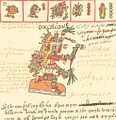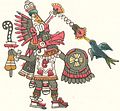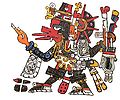Quetzalcoatl
Quetzalcoatl ( Nahuatl Quetzalcōātl = " Quetzal snake " or "shining tail feather snake"; Mayathan or Itzá Kukulcán , Quiché Q'uq'umatz ) is a syncretistic deity of several Mesoamerican cultures, including the Toltecs , the Aztecs and the Maya . The god Tlahuizcalpantecuhtli is likely to be a special form of Quetzalcoatl.

shape

In the early depictions, Quetzalcoatl became zoomorphic ; H. depicted as a large rattlesnake whose body is covered with the feathers of the holy quetzal bird - for example on stele 19 (around 900 BC) in the Olmec city of La Venta . In Teotihuacán , a temple pyramid - later built over - whose facade is covered over and over with depictions of a feathered snake, was named after him. The facade of the main pyramid of Xochicalco is also covered with reliefs of a feathered serpent.
The Aztecs also saw Quetzalcoatl as a bearded and fair-skinned man; this probably refers to the Toltec king Ce Acatl , who took his name as a priest of the god Quetzalcoatl. In the Aztec Codices it is represented in an abstracted-human way; here he often wears a star-shaped breastplate that refers to the wandering star Venus .
mythology
Toltec mythology
The Toltecs worshiped Quetzalcoatl as the main god and creator. The morning star was considered his heart. His brother and opponent was Tezcatlipoca .
Aztec mythology
In Aztec mythology , Quetzalcoatl is the god of wind, sky, earth and a creator god. It symbolizes the ocean . In Teotihuacán he was worshiped as a god of nature early on ( Temple of Quetzalcoatl ). Its main sanctuary was in Cholula . He was considered the ruler of the second world age .
Tradition has it that Quetzalcoatl, when embarking and departing for the mysterious Tlapallan , announced that he would one day return across the Atlantic Ocean with his entourage to take possession of his empire again. This is given as one of the reasons why the ruler Moctezuma II only hesitantly opposed the Spanish conquerors under Hernán Cortés in the 16th century : he could not rule out having to do with the messengers of the god. In more recent research, this explanation is interpreted as a historical myth that can be traced back to Spanish justification intentions. Hernán Cortés did not have permission to conquer what is now Mexico, but his mission was to explore. Since the conqueror was accused by a Spanish court, he wrote a letter to the emperor, in which he reported that the Aztecs had already surrendered their empire to him before fighting broke out because they saw an expected ruler in Cortés who would come back one day. Thus, the conquest of Mexico could be interpreted as the suppression of an Aztec uprising and Cortés could escape the certain death penalty for the unauthorized conquest.
Mayan myths
Quetzalcoatl was worshiped by the Maya under the name Kukulcan . The Quiché Indians in the highlands of Guatemala called him Q'uq'umatz; he is mentioned in various places in the Popol Vuh .
photos
Quetzalcoatl as a feathered snake in Codex Telleriano-Remensis
Quetzalcoatl in Codex Borbonicus
Quetzalcoatl in the Codex Magliabechiano
Quetzalcoatl in Codex Borgia
Trivia
Quetzalcoatl is one of the central characters in the novel 'Die gefiederte Schlange' (orig. The Plumed Serpent ) by DH Lawrence . An asteroid and the Upper Cretaceous pterosaur Quetzalcoatlus , the largest known flight animal in the history of the earth, are also named after him.
literature
- Hanns J. Prem : The Aztecs. History - culture - religion. Verlag CH Beck, Munich 2006, ISBN 3-406-45835-1 .
- Günter Lanczkowski : The religions of the Aztecs, Maya and Inca. Scientific Book Society, Darmstadt 1989, ISBN 3-534-03222-5 .
Web links
Individual evidence
- ↑ William H. Prescott : The Conquest of Mexico . DBG , Berlin 1956; P. 68f
- ^ Camilla Townsend: Burying the White Gods: New Perspectives on the Conquest of Mexico . The American Historical Review 108, 3, 2003, pp. 659-687 .
- ^ A b Roland Bernhard: History myths about Hispanoamerica. Discovery, conquest and colonization in German and Austrian textbooks of the 21st century. Vandenhoeck and Ruprecht, Göttingen 2013, ISBN 978-3-8471-0204-5 , p. 151 ( limited preview in Google Book search).
- ↑ Matthew Restall: Seven Myths of the Spanish Conquest. Oxford University Press, Oxford 2003, pp. 7 ff. And others; Daniel Grana-Behrens: The disintegration of the Aztec state in central Mexico 1516–1521. In: John Emeka Akude et al. (Ed.): Political rule beyond the state. On the transformation of legitimacy in the past and present. Springer VS, Wiesbaden 2011, p. 83ff .; Roland Bernhard: History myths about Hispanic America. Discovery, conquest and colonization in German and Austrian textbooks of the 21st century. Vandenhoeck and Ruprecht, Göttingen 2013, p. 120 ff .




